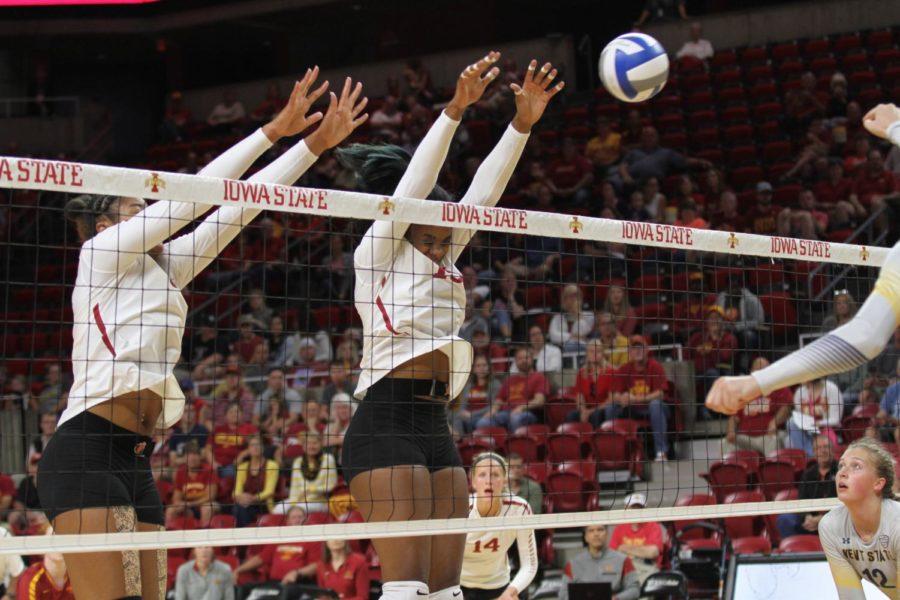After Cyclone Invitational, Iowa State volleyball has many offensive weapons
August 26, 2017
Prior to the Cyclone Invitational this weekend, head coach Christy Johnson-Lynch noted her concern towards the Iowa State women’s volleyball offensive struggles.
“We need to put the ball away and run an offense that allows us to do that,” Johnson-Lynch said before the Cyclone Invitational. “I think offensively, [I’m] just looking for some more firepower from several different people.”
Throughout the weekend, the Cyclones received some of that offensive firepower, propelling them to a 3-0 finish. Iowa State didn’t receive the production from one source, but rather from multiple players.
Friday night, the Cyclones swept the Kent State Golden Flashes. Iowa State’s outside hitters struggled against Kent State, but the middle blockers picked up the slack.
“I thought our block really came alive there at the end,” Johnson-Lynch said. “I thought Grace [Lazard] came alive both offensively and defensively.”
Middle blockers Grace Lazard and Samara West each had 10 kills, while senior middle blocker Alexis Conaway recorded six kills. Each member of the trio had a hitting percentage of .400 or higher.
“[The offensive versatility] takes the pressure off of one person,” Conaway said.
After the match, Lazard and West had an idea why the middle blockers had the success they did.
“I think switching to the swing block [has improved our blocking],” Lazard said. “I think that really helped us a lot. Everyone [on the team] is practicing it.”
The swing block is a more aggressive version of a standard block. Instead of the blockers just putting their hands up, they swing them forward, too.
“I think if we continue to keep it up and keep getting stronger, honestly, we could literally be a brick wall,” Lazard said.
Johnson-Lynch is confident even when one of her position units is struggling.
“Last weekend our middles struggled and our outsides went off, so it could vary night-to-night,” Johnson-Lynch said after the Kent State match. “Tonight, our middles and Samara [were] really hot offensively, and we had three good options going.”
Saturday featured Iowa State’s second match of the Cyclone Invitational, facing off against Omaha.
The Cyclones rested West, allowing freshman Avery Rhodes to make her debut.
Against Omaha, Iowa State spread the offensive attack out even more. Without West and with less dominance from the middle blockers, the Cyclones featured different weapons.
Sophomore Josie Herbst started the match, making her first appearance in Cardinal and Gold. Herbst seized the opportunity and contributed eight kills and three digs.
Junior hitter Jess Schaben received limited playing time in the first two sets. In Schaben’s absence, senior Genesis Miranda stepped up.
Miranda finished the match with 11 kills and eight digs. Senior Monique Harris played a key role in setting up Iowa State’s hitters, adding 33 assists in the match.
“[The versatility of the offense] is huge,” Harris said. “As the setter, being able to set anybody and knowing that we have production coming from everywhere.”
The Cyclones relied less on Lazard and Conaway with the duo contributing 17 combined kills. Against Omaha, Iowa State showcased its depth and player versatility.
In the final match of the Cyclone Invitational, Iowa State faced a challenge in New Mexico. The Cyclones received big production from yet another different player.
Junior hitter Hannah Bailey finished the match with seven kills and a hitting percentage of .500. Along with Bailey, Iowa State utilized a balanced attack from the blockers and hitters.
Johnson-Lynch said this match was the best she has seen of the Cyclones offensively. Six of Iowa State’s players each had seven or more kills.
The experienced core of Bailey, Schaben, West, Miranda, Conaway and Lazard combined for 45 kills in the Cyclone Invitational finale.
The assists were also distributed more evenly with Harris finishing with 24 and freshman Piper Mauck with 16.
This weekend exposed inconsistencies with the blockers and hitters, but it also proved that when one unit is struggling the other can bail them out.
“I think our setters are learning how to get one player going, get the other side thinking they have to do something to slow her down,” Johnson-Lynch said. “And as soon as they start to do that, then going somewhere else.”







